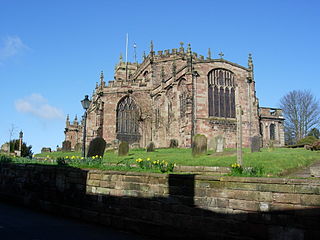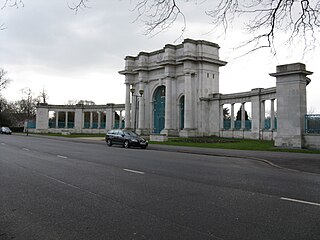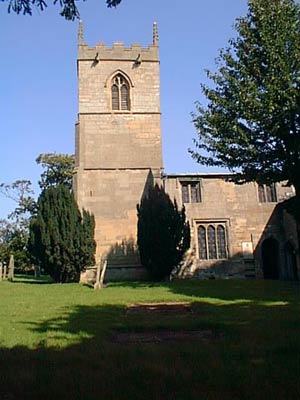
St Oswald's Church stands on the highest point in the market town of Malpas, Cheshire, England, on or near the site of a Norman motte and bailey castle. The church is recorded in the National Heritage List for England as a designated Grade I listed building and is recognised as being one of the best examples in Cheshire of a late 15th to early 16th-century church. It is an active Anglican parish church in the diocese of Chester, the archdeaconry of Chester and the deanery of Malpas. Its benefice is combined with those of St John, Threapwood, and Holy Trinity, Bickerton. Alec Clifton-Taylor includes it in his list of 'best' English parish churches.

St Bartholomew's Church is in the village of Great Barrow in the civil parish of Barrow, Cheshire, England. It is recorded in the National Heritage List for England as a designated Grade II* listed building. It is an active Anglican parish church in the diocese of Chester, the archdeaconry of Chester and the deanery of Chester.

St. Mary's Church, Attenborough is a parish church in the Church of England in the village of Attenborough, Nottinghamshire.

St Andrew's Church is a redundant Church of England parish church in the village of Wroxeter, Shropshire, England. It is recorded in the National Heritage List for England as a designated Grade I listed building, and is under the care of the Churches Conservation Trust. Both the village of Wroxeter and the church are in the southwest corner of the former Roman town of Viroconium.

The Church of St Mary the Virgin is an Anglican church in Goosnargh, a village north of Preston in Lancashire, England. The church dates from the Middle Ages; it was enlarged in the 16th century and restored twice in the 19th century.

All Saints' Church, Winthorpe is a Grade II listed parish church in the Church of England in Winthorpe, Nottinghamshire, England. The current building, the construction of which was completed in 1888, is at least the third version of the church, which dates back to at least the early 13th century. All Saints' Church was commissioned by the church rector, Edward Handley, in memory of one of his relatives.

War Memorial Cross, Beeston is a Grade II listed structure in Beeston, Nottinghamshire.

The City War Memorial, Nottingham, also known as the Nottingham Municipal War Memorial and the City of Nottingham War Memorial, is the main war memorial for the city of Nottingham in England. It comprises a memorial arch of Portland stone with three openings and wrought iron gates, and stone flanking arcades. It was unveiled in 1927 beside a new park overlooking the River Trent, and became a Grade II listed building in 1972.

The Boer War Memorial stands in the shopping precinct of Winsford, Cheshire, England. It consists of the statue of a soldier in uniform standing on a plinth, and it was unveiled in 1906. It originally stood on a different site in the town and was moved to its present position in the 1960s. In addition to recording the names of those who were lost in the conflict, it also contains the names of those who survived.

Southport War Memorial is in London Square, Lord Street, Southport, Merseyside, England. It consists of an obelisk flanked by two colonnades in the form of Greek temples. Outside the colonnades are memorial gardens, each containing a Pool of Remembrance and fountains. The memorial was designed by the local architects Grayson and Barnish, and the carving was executed by Herbert Tyson Smith. It was unveiled in 1923 by the Earl of Derby. Following the Second World War and subsequent conflicts further inscriptions and names have been added. The memorial is recorded in the National Heritage List for England as a designated Grade II* listed building.

Trumpington War Memorial is a war memorial cross in the village of Trumpington, on the southern outskirts of Cambridge. The memorial was designed by Eric Gill. It was unveiled in 1921, and became a Grade II* listed building in 1999.

St Saviour's War Memorial is a war memorial on Borough High Street, in the former parish of Southwark St Saviour, to south of the River Thames in London. It became a Grade II listed building in 1998 and was upgraded to Grade II* in 2018.

The Dulwich Old College War Memorial is located in the forecourt of Dulwich Old College on College Road in Dulwich in the London Borough of Southwark. It marks the deaths of the former pupils of the college who died in the First World War between 1914 and 1919. The memorial is made from Hopton Wood stone and was designed by William Douglas Caröe. It was unveiled in 1921. It has been grade II listed on the National Heritage List for England since May 2010. The heritage listing places the memorial within a "visual and contextual relationship" with the Grade II listed Old College building and the entrance gates and piers of the Old College, also Grade II listed.

The Dulwich College War Memorial is located at the eastern front of Dulwich College on College Road in Dulwich in the London Borough of Southwark. It commemorates the alumni of the college who died in both the First and Second World Wars. The memorial was designed by W. H. Atkin-Berry, an alumnus of the college. It was unveiled on 17 June 1921, the Dulwich College Founder's Day, by Major General Sir Webb Gillman, and dedicated by the Dean of Durham, James Welldon. Gillman was an alumnus of the college, and Welldon had served as Master of Dulwich College from 1883 to 1885. It has been Grade II listed on the National Heritage List for England since May 2010. The heritage listing places the memorial within a "visual and contextual relationship" with the Grade II* listed Main College building.

Blackmoor War Memorial is a First World War memorial cloister in Blackmoor, near Liss, in Hampshire. The memorial stands on the north side of the main road, with the Church of St Matthew to the east and the village school to the west. It was designed by Sir Herbert Baker, and comprises a three-sided wood-framed arcade, open to the south, arranged around lawn with a memorial cross. Several memorial plaques and a fountain by Sir Charles Wheeler are mounted on the walls of the arcade. It is one of around 130 Grade II* listed war memorials in England.

St Mary's Church is a parish church in Goudhurst, Kent, England. It is a Grade I listed building.

The Lenham Cross is a chalk cross carved into the hillside to the north of Lenham in Kent, in England.






















